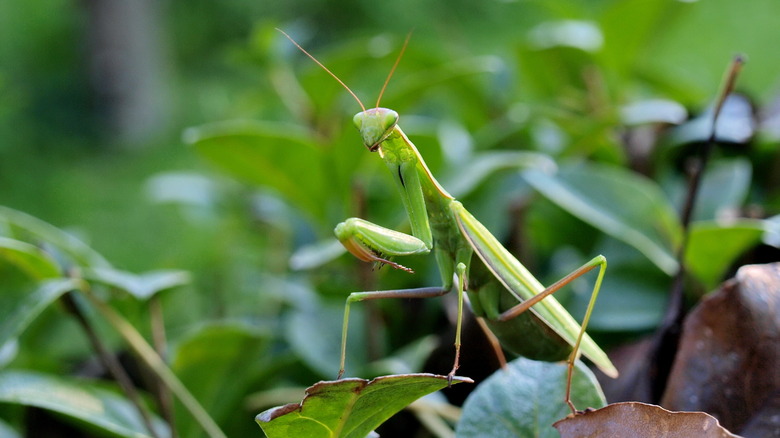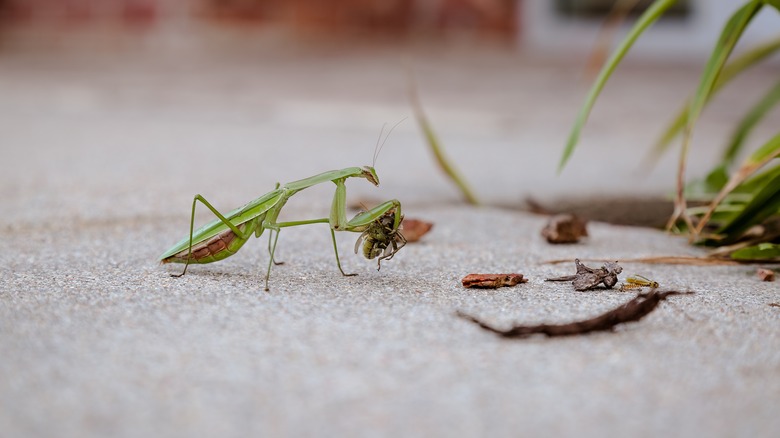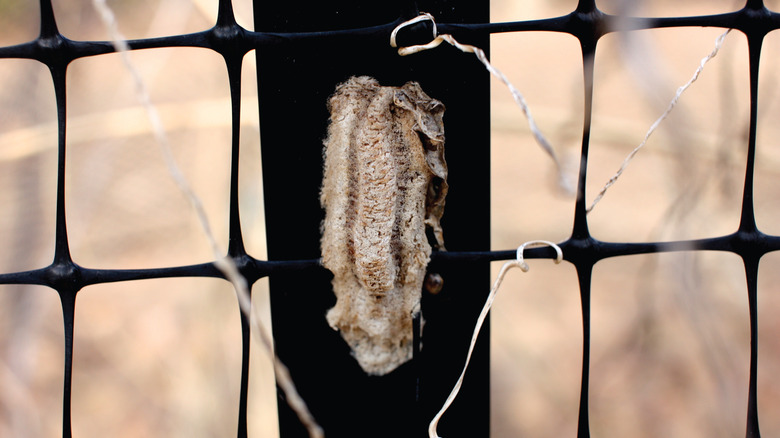Should You Think Twice Before Encouraging Praying Mantises In Your Garden?
Keeping praying mantises around may seem like good common sense. You want to bring good insects into your garden, and they're effective pest controllers. As with a lot of garden advice, though, things aren't that simple. While many people believe the mantis is the solution to their insect invasion problems, these feisty, alien-like bugs are, in fact, ravenous and indiscriminate eaters. They find pesky and beneficial insects equally delicious. Plus, the most successful species of praying mantis were introduced to the U.S., and in many cases, their potential for invasiveness outweighs their usefulness.
Of the 20 species of praying mantid (mantis refers to the genus, mantid refers to the group) in the U.S., three are commonly found in residential gardens. The Chinese mantis (Tenodera sinensis) was introduced to North America by accident in the late 1800s. Outside of insects, the largest members of this species have been known to eat lizards, frogs ... even hummingbirds. The European mantis (Mantis religiosa) was brought to America to control gypsy moth populations. The third is the native Carolina mantid (Stagmomantis carolina). Though it's found all over the country, especially from New Jersey to Florida, it's smaller than its imported counterparts and is often outcompeted by them.
Gardener's friend
Praying mantises have long been considered beneficial because they eat pest insects. They sit motionless on a plant, using a combination of leaf-like camouflage, quick reflexes, excellent eyesight (and decent sense of smell), and long, spiny front pinchers to capture aphids, beetles, grasshoppers, and more. Keeping predators around reduces the need for pesticides and other harmful controls. What's more, any mantid population in your garden is unlikely to get out of control because they can even pray on one another. Plus, at least in cooler parts of the continent, they rarely survive past autumn — though their egg cases, or ootheca, do.
That the introduced species of mantid — Chinese and European — have already been around for a century without causing significant ecological harm points to them being a neutral presence in the garden at worst. In 2021, facilities management at Adelphi University New York introduced praying mantises into their expansive Garden City campus for eco-friendly cricket, beetle, and grasshopper control, so it can't be a bad idea if colleges are supporting their use. Their large size means they're easy to spot, making them an excellent etymological education species for kids, While some people even keep them as pets.
Feared foe
The issue is, however, that praying mantises are crafty carnivores — they'll eat almost anything that moves — even creatures as big as mice. They're not included in the University of Hawaii at Manoa Master Gardener Program's list of beneficial insects for this reason. They can also be fussy with certain pests, like aphids. Other experts state that issues like lackadaisical feeding schedules, slow reproduction, lack of ability to survive cold weather (the common Chinese praying mantis, at least), and preference for eating helpful pollinators like bees and butterflies make mantids a less-than-desirable biological control option for home gardeners.
If you still want to introduce mantids to your garden, cultivate a native species. In late fall and early winter, go on a neighborhood hunt for ootheca attached to fence posts and branches. The Carolina mantises egg sacks are small with a distinctive beige stripe down the center. You can also buy egg cases when in season – The Praying Mantis Shop has ootheca available from December. Praying mantids prefer tall grass-like and flowering plants, so keep your lawn long and cultivate favored herbs like dill and marigolds. You might want to add basil to your garden, too. Basil flowers and foliage attract the bugs that mantises love to feed on.


